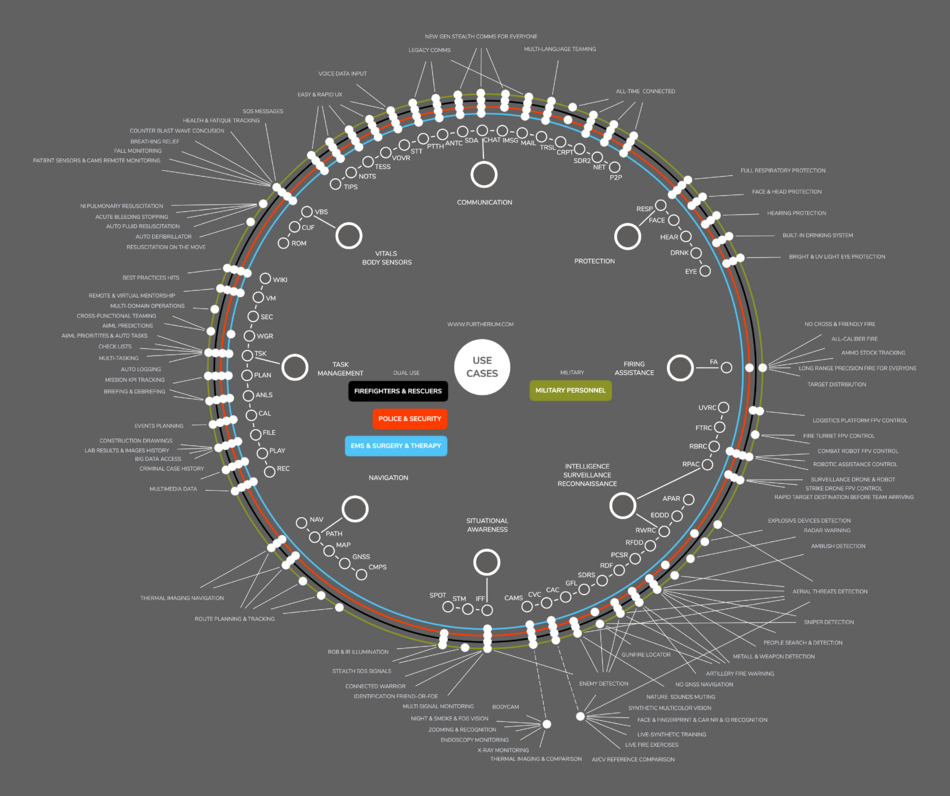| Section
|
Pain
|
Solutions
|
| Tactical Situational Awareness
|
- Very high casualties (over 20%) from friendly fire in combat environments (Israel, Ukraine);
- Fog of war;
- AI BMSs exist, but the data is not even available to most NCOs on the battlefield;
- Effective training in Live-Synthetic Training Environments cannot yet be implemented;
|
|
| Omnichannel Comms
|
- Communication only through commander;
- Mostly voice communication, not high quality;
- Sessions need to be shorter, much shorter;
- Not every unit has BLOS communication;
- Number of bands and networks is very limited;
- Almost no multimedia and data transmission;
- Instant messaging is still gesture-based (“hand and arm signals”);
- No message re-reading/listening;
- Additional skills are needed to use encrypted communications securely;
- Each session through omnidirectional antennas creates vulnerabilities for the transmitter and operators;
- NATO units use different languages to communicate;
- Encryption of voice traffic is more complex than encryption of short digital data packets;
- Signal relay (transceiver) stations have vulnerabilities;
|
|
| RC Universal Controller
|
- Drones are inexpensive, but cannot be used on a mass scale by everyone;
- Drone and robot operators are completely disconnected from reality while they are busy controlling;
- Fire turret operators work in high-risk environments, extremely rare;
|
|
| RF Scanning and Radio Direction Finding
|
- These operations are performed only by communications engineers, but they are not on the front line or behind enemy lines;
|
|
| Notifications, User Tips, Tasks, Mission Tracking
|
- People make mistakes all the time, forget important information;
- People rely on experience ("survivor error") rather than data;
- Pre-mission briefing and debriefing identify mistakes, but they are repeated;
- Just in Time tips based on best practices, taking all factors into account, would definitely not prevent the user from making a decision (but it doesn't exist yet);
|
|
| Navigation
|
- Used the ATAK-MIL system on Samsung Galaxy 10" tablets (there are flaws);
|
|
| Multi-Domain Operations
|
- Reaction time is not short enough;
- Not enough information to make decisions;
|
|
| Night Vision, Fire Spotting
|
- Spotters adjust fire, which is only used in sniper teams, artillery, aviation, and the Navy;
- Often fire spotters are at great risk;
- How do you distribute targets among multiple individuals in a unit to hit all targets at the same time and avoid crossfire? (no solutions)
- How to capture and hold multiple targets by one person? How to prioritize the targets? (no solutions)
- Non-IR night vision devices cost tens of thousands and are available to a few (armored, Special Operations Forces);
- The image quality of night vision devices is not high;
- Optical sights (SWIR + LWIR) have a small field of view and are unavailable to most;
- Accurate fire at ranges greater than 600 yards requires specialized training;
- Huge ammunition costs due to inaccurate fire and the practice of harassing fire;
|
|
| Computer Vision, Computer Audition
|
- Not used in practice;
- Detection and recognition of objects, motion, heat signatures, smoke trails, flashes, including at night, in fog, behind clouds, behind vegetation, including beyond human vision, as well as source localization, real-time data exchange - not available;
- Sound signature detection, filtering, subtraction for clear recognition, recognition of volume levels below human capability - not available;
- RF signature detection of reflected signals in passive safe mode from metal objects of several inches or more (even behind concrete barriers) - not available;
|
|
| Artificial Intelligence, Human Augmentation
|
- There is a desire to use only within Battlefield Management Systems, but implementation is difficult;
- "Soldier as Sensor" is still only a concept;
- Humans are not capable of performing many complex tasks under stress;
- To perform many tasks effectively requires over 4 years of additional training and practice;
|
Human Augmentation
|
| Augmented Reality
|
- Undeniable battlefield advantage in every unit, but Microsoft IVAS[1] attempts are going in the wrong direction and are therefore unsuccessful;
|
Augmented Reality Head-Up Fullface Mask
|
| Vitals Body Sensors, Care Under Fire, Resuscitation on the Move
|
- Not used in practice;
- No data collection and sharing;
- First aid can only be provided by someone who is nearby;
- Effective resuscitation in battlefield conditions is difficult and only possible after CASEVAC arrives;
|
|
| Protection
|
- How do I isolate my voice so that I don't de-disguise myself? How to communicate with others?
- Either face protection or respiratory protection, but not both at once;
- Conventional respirators are available but rarely used (they are difficult to breathe in, and don't use CPAP, continuous positive airway pressure);
- Respiratory protection is inadequate (it doesn't protect against viruses and some toxic aerosols);
- In the event of a sudden need, most people will not realize in time to put on a respirator;
- Drinking system is separate (not integrated), requires removing protection or not drinking;
- Hearing protection against loud noises and blast waves is not available to many;
- Hearing protection is not used all the time due to discomfort and loss of connection to reality;
|
Protection
|
| Integration
|
- There is no integration of all of the above;
|
Integration
|
| Costs
|
- Where can we get over a hundred thousand dollars to provide every soldier on the battlefield with the technology of modern warfare? To protect against modern risks!
|
Less than $16k for a 4 year contract on average
|
![]() →redirect Further information: Public:ARHUDFM_Manifesto, Public:Applications, Public:ARHUDFM Features Summary, Public:Graphical User Interface
→redirect Further information: Public:ARHUDFM_Manifesto, Public:Applications, Public:ARHUDFM Features Summary, Public:Graphical User Interface
